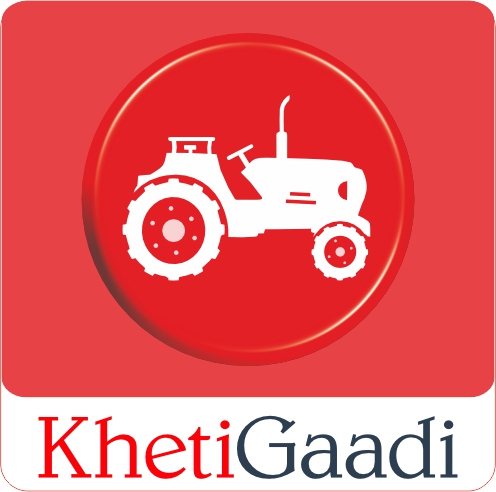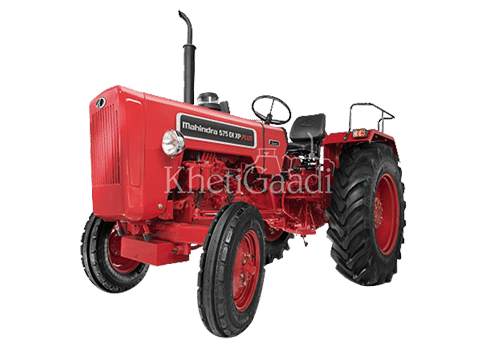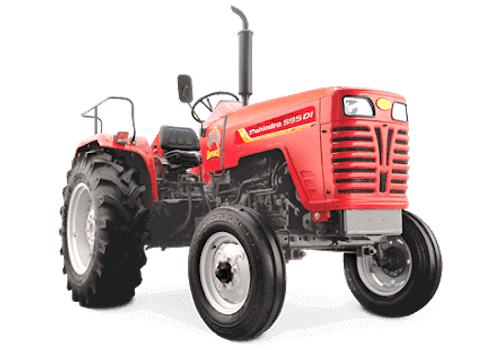Mahindra Tractor Price: A Comprehensive Guide to Popular Models
Mahindra Tractors have gained a strong reputation for their durability, affordability, and reliability, making them one of the leading choices among farmers and agricultural workers. With a wide variety of models catering to different farming needs, Mahindra offers tractors for both small and large-scale operations. In this article, we’ll take a closer look at some of the top Mahindra tractor models, their specifications, and their prices, covering essential models such as the Mahindra 575 DI XP Plus, Mahindra 475 DI, Mahindra 265 DI, Mahindra 275 DI, and more.in this article get all the data about mahindra tractor prices, specifications, customer reviews, and all.
Overview of Mahindra Tractors
Mahindra has long been a pioneer in the agricultural machinery sector, manufacturing tractors that cater to various terrains and farming operations. The company's focus on customer satisfaction, combined with an expansive dealer network and after-sales service, has made it a favorite among farmers across the globe. Whether it’s high horsepower for large farms or compact tractors for small operations, Mahindra’s versatile lineup meets a range of agricultural requirements.
Mahindra Tractor Prices
When it comes to affordability and value for money, Mahindra tractors have earned a reputation for offering high performance at competitive prices. Below is a look at the prices of some popular Mahindra tractor models, along with their key features and specifications.
1. Mahindra 575 DI XP Plus Price
The Mahindra 575 DI XP Plus is one of the most popular tractors in the Indian market, known for its robust performance and advanced features. This tractor is equipped with a 4-cylinder engine that generates around 47 HP, making it ideal for medium and large-scale farming activities.
- Engine Power: 47 HP
- Fuel Tank Capacity: 48 liters
- Transmission: 8 forward and 2 reverse gears
- Hydraulic Capacity: 1500 kg
Price: The Mahindra 575 DI XP Plus price ranges between ₹6.75 lakhs to ₹7.15 lakhs, depending on location and dealer offers.
2. Mahindra Tractor 475 DI Price
The Mahindra 475 DI is another widely used model, known for its efficiency in carrying out multiple farming operations. It comes with a 42 HP engine, which is suited for moderate farming tasks such as plowing and tilling.
- Engine Power: 42 HP
- Fuel Tank Capacity: 48 liters
- Transmission: 8 forward and 2 reverse gears
- Hydraulic Capacity: 1500 kg
Price: The Mahindra tractor 475 price starts at approximately ₹6.20 lakhs and can go up to ₹6.60 lakhs.
3. Mahindra 265 DI Price
For farmers looking for a more affordable yet powerful option, the Mahindra 265 DI is an excellent choice. This tractor is equipped with a 30 HP engine, suitable for small to medium-sized farms. Its compact design makes it an efficient machine for narrow spaces and small-scale agricultural tasks.
- Engine Power: 30 HP
- Fuel Tank Capacity: 45 liters
- Transmission: 8 forward and 2 reverse gears
- Hydraulic Capacity: 1200 kg
Price: The Mahindra 265 DI price typically ranges from ₹5.20 lakhs to ₹5.60 lakhs.
4. Mahindra Small Tractor Price
Mahindra offers a variety of small tractors designed for lightweight farming activities, orchards, and small landholdings. These tractors are compact, efficient, and offer great fuel economy, making them a preferred choice for small-scale farmers.
Some popular models in this segment include the Mahindra Yuvraj 215 NXT, which comes with a 15 HP engine and is ideal for small-scale horticultural applications.
Price: The Mahindra small tractor price generally starts from ₹3.20 lakhs, depending on the model and features.
5. Mahindra 275 DI XP Plus Price
The Mahindra 275 DI XP Plus is another high-performance tractor that comes with a 39 HP engine, which is well-suited for carrying out heavy-duty tasks on medium-sized farms. It features durable components, a powerful engine, and a sturdy design that enhances productivity on the farm.
- Engine Power: 39 HP
- Fuel Tank Capacity: 45 liters
- Transmission: 8 forward and 2 reverse gears
- Hydraulic Capacity: 1500 kg
Price: The Mahindra 275 DI XP Plus price is estimated to be around ₹5.75 lakhs to ₹6.10 lakhs.
6. Mahindra 585 DI XP Plus Price
A powerful and versatile tractor, the Mahindra 585 DI XP Plus is designed for large-scale farming. It comes with a 50 HP engine and provides high fuel efficiency, making it suitable for long hours of operation in the fields.
- Engine Power: 50 HP
- Fuel Tank Capacity: 60 liters
- Transmission: 8 forward and 2 reverse gears
- Hydraulic Capacity: 1640 kg
Price: The Mahindra 585 DI XP Plus price is approximately ₹7.25 lakhs to ₹7.70 lakhs.
Factors That Influence Mahindra Tractor Prices
https://khetigaadi.com/new-tractor-brand/Mahindra/en
Mahindra Tractors have gained a strong reputation for their durability, affordability, and reliability, making them one of the leading choices among farmers and agricultural workers. With a wide variety of models catering to different farming needs, Mahindra offers tractors for both small and large-scale operations. In this article, we’ll take a closer look at some of the top Mahindra tractor models, their specifications, and their prices, covering essential models such as the Mahindra 575 DI XP Plus, Mahindra 475 DI, Mahindra 265 DI, Mahindra 275 DI, and more.in this article get all the data about mahindra tractor prices, specifications, customer reviews, and all.
Overview of Mahindra Tractors
Mahindra has long been a pioneer in the agricultural machinery sector, manufacturing tractors that cater to various terrains and farming operations. The company's focus on customer satisfaction, combined with an expansive dealer network and after-sales service, has made it a favorite among farmers across the globe. Whether it’s high horsepower for large farms or compact tractors for small operations, Mahindra’s versatile lineup meets a range of agricultural requirements.
Mahindra Tractor Prices
When it comes to affordability and value for money, Mahindra tractors have earned a reputation for offering high performance at competitive prices. Below is a look at the prices of some popular Mahindra tractor models, along with their key features and specifications.
1. Mahindra 575 DI XP Plus Price
The Mahindra 575 DI XP Plus is one of the most popular tractors in the Indian market, known for its robust performance and advanced features. This tractor is equipped with a 4-cylinder engine that generates around 47 HP, making it ideal for medium and large-scale farming activities.
- Engine Power: 47 HP
- Fuel Tank Capacity: 48 liters
- Transmission: 8 forward and 2 reverse gears
- Hydraulic Capacity: 1500 kg
Price: The Mahindra 575 DI XP Plus price ranges between ₹6.75 lakhs to ₹7.15 lakhs, depending on location and dealer offers.
2. Mahindra Tractor 475 DI Price
The Mahindra 475 DI is another widely used model, known for its efficiency in carrying out multiple farming operations. It comes with a 42 HP engine, which is suited for moderate farming tasks such as plowing and tilling.
- Engine Power: 42 HP
- Fuel Tank Capacity: 48 liters
- Transmission: 8 forward and 2 reverse gears
- Hydraulic Capacity: 1500 kg
Price: The Mahindra tractor 475 price starts at approximately ₹6.20 lakhs and can go up to ₹6.60 lakhs.
3. Mahindra 265 DI Price
For farmers looking for a more affordable yet powerful option, the Mahindra 265 DI is an excellent choice. This tractor is equipped with a 30 HP engine, suitable for small to medium-sized farms. Its compact design makes it an efficient machine for narrow spaces and small-scale agricultural tasks.
- Engine Power: 30 HP
- Fuel Tank Capacity: 45 liters
- Transmission: 8 forward and 2 reverse gears
- Hydraulic Capacity: 1200 kg
Price: The Mahindra 265 DI price typically ranges from ₹5.20 lakhs to ₹5.60 lakhs.
4. Mahindra Small Tractor Price
Mahindra offers a variety of small tractors designed for lightweight farming activities, orchards, and small landholdings. These tractors are compact, efficient, and offer great fuel economy, making them a preferred choice for small-scale farmers.
Some popular models in this segment include the Mahindra Yuvraj 215 NXT, which comes with a 15 HP engine and is ideal for small-scale horticultural applications.
Price: The Mahindra small tractor price generally starts from ₹3.20 lakhs, depending on the model and features.
5. Mahindra 275 DI XP Plus Price
The Mahindra 275 DI XP Plus is another high-performance tractor that comes with a 39 HP engine, which is well-suited for carrying out heavy-duty tasks on medium-sized farms. It features durable components, a powerful engine, and a sturdy design that enhances productivity on the farm.
- Engine Power: 39 HP
- Fuel Tank Capacity: 45 liters
- Transmission: 8 forward and 2 reverse gears
- Hydraulic Capacity: 1500 kg
Price: The Mahindra 275 DI XP Plus price is estimated to be around ₹5.75 lakhs to ₹6.10 lakhs.
6. Mahindra 585 DI XP Plus Price
A powerful and versatile tractor, the Mahindra 585 DI XP Plus is designed for large-scale farming. It comes with a 50 HP engine and provides high fuel efficiency, making it suitable for long hours of operation in the fields.
- Engine Power: 50 HP
- Fuel Tank Capacity: 60 liters
- Transmission: 8 forward and 2 reverse gears
- Hydraulic Capacity: 1640 kg
Price: The Mahindra 585 DI XP Plus price is approximately ₹7.25 lakhs to ₹7.70 lakhs.
Factors That Influence Mahindra Tractor Prices
https://khetigaadi.com/new-tractor-brand/Mahindra/en
Mahindra Tractor Price: A Comprehensive Guide to Popular Models
Mahindra Tractors have gained a strong reputation for their durability, affordability, and reliability, making them one of the leading choices among farmers and agricultural workers. With a wide variety of models catering to different farming needs, Mahindra offers tractors for both small and large-scale operations. In this article, we’ll take a closer look at some of the top Mahindra tractor models, their specifications, and their prices, covering essential models such as the Mahindra 575 DI XP Plus, Mahindra 475 DI, Mahindra 265 DI, Mahindra 275 DI, and more.in this article get all the data about mahindra tractor prices, specifications, customer reviews, and all.
Overview of Mahindra Tractors
Mahindra has long been a pioneer in the agricultural machinery sector, manufacturing tractors that cater to various terrains and farming operations. The company's focus on customer satisfaction, combined with an expansive dealer network and after-sales service, has made it a favorite among farmers across the globe. Whether it’s high horsepower for large farms or compact tractors for small operations, Mahindra’s versatile lineup meets a range of agricultural requirements.
Mahindra Tractor Prices
When it comes to affordability and value for money, Mahindra tractors have earned a reputation for offering high performance at competitive prices. Below is a look at the prices of some popular Mahindra tractor models, along with their key features and specifications.
1. Mahindra 575 DI XP Plus Price
The Mahindra 575 DI XP Plus is one of the most popular tractors in the Indian market, known for its robust performance and advanced features. This tractor is equipped with a 4-cylinder engine that generates around 47 HP, making it ideal for medium and large-scale farming activities.
- Engine Power: 47 HP
- Fuel Tank Capacity: 48 liters
- Transmission: 8 forward and 2 reverse gears
- Hydraulic Capacity: 1500 kg
Price: The Mahindra 575 DI XP Plus price ranges between ₹6.75 lakhs to ₹7.15 lakhs, depending on location and dealer offers.
2. Mahindra Tractor 475 DI Price
The Mahindra 475 DI is another widely used model, known for its efficiency in carrying out multiple farming operations. It comes with a 42 HP engine, which is suited for moderate farming tasks such as plowing and tilling.
- Engine Power: 42 HP
- Fuel Tank Capacity: 48 liters
- Transmission: 8 forward and 2 reverse gears
- Hydraulic Capacity: 1500 kg
Price: The Mahindra tractor 475 price starts at approximately ₹6.20 lakhs and can go up to ₹6.60 lakhs.
3. Mahindra 265 DI Price
For farmers looking for a more affordable yet powerful option, the Mahindra 265 DI is an excellent choice. This tractor is equipped with a 30 HP engine, suitable for small to medium-sized farms. Its compact design makes it an efficient machine for narrow spaces and small-scale agricultural tasks.
- Engine Power: 30 HP
- Fuel Tank Capacity: 45 liters
- Transmission: 8 forward and 2 reverse gears
- Hydraulic Capacity: 1200 kg
Price: The Mahindra 265 DI price typically ranges from ₹5.20 lakhs to ₹5.60 lakhs.
4. Mahindra Small Tractor Price
Mahindra offers a variety of small tractors designed for lightweight farming activities, orchards, and small landholdings. These tractors are compact, efficient, and offer great fuel economy, making them a preferred choice for small-scale farmers.
Some popular models in this segment include the Mahindra Yuvraj 215 NXT, which comes with a 15 HP engine and is ideal for small-scale horticultural applications.
Price: The Mahindra small tractor price generally starts from ₹3.20 lakhs, depending on the model and features.
5. Mahindra 275 DI XP Plus Price
The Mahindra 275 DI XP Plus is another high-performance tractor that comes with a 39 HP engine, which is well-suited for carrying out heavy-duty tasks on medium-sized farms. It features durable components, a powerful engine, and a sturdy design that enhances productivity on the farm.
- Engine Power: 39 HP
- Fuel Tank Capacity: 45 liters
- Transmission: 8 forward and 2 reverse gears
- Hydraulic Capacity: 1500 kg
Price: The Mahindra 275 DI XP Plus price is estimated to be around ₹5.75 lakhs to ₹6.10 lakhs.
6. Mahindra 585 DI XP Plus Price
A powerful and versatile tractor, the Mahindra 585 DI XP Plus is designed for large-scale farming. It comes with a 50 HP engine and provides high fuel efficiency, making it suitable for long hours of operation in the fields.
- Engine Power: 50 HP
- Fuel Tank Capacity: 60 liters
- Transmission: 8 forward and 2 reverse gears
- Hydraulic Capacity: 1640 kg
Price: The Mahindra 585 DI XP Plus price is approximately ₹7.25 lakhs to ₹7.70 lakhs.
Factors That Influence Mahindra Tractor Prices
https://khetigaadi.com/new-tractor-brand/Mahindra/en
0 Comments
0 Shares
387 Views
0 Reviews








